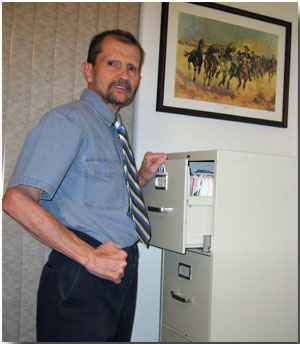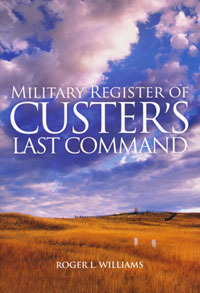|
Webmaster's Note: Historian
Roger Williams discusses his decades of research and writing his new book Military
Register of Custer's Last Command, how his work to document the over 600
members of the 7th Cavalry continues, and his first visit to Little Bighorn
Battlefield in 1952. Jump here to read the
review of the book.
November 2009
Bob Reece: Is the publication of your book
the end of your research or does it continue?
Roger Williams: The book is pretty much trail’s end, but like a Monday
morning quarterback, I would welcome an opportunity to make a few
revisions…deletions and re-wordings here and there.
B.R. If it continues, what are you working on
now? At this minute. What is on your desk that is bugging you; that you need to
find the answer to.
R.W. Most of the bugaboos were gradually put to rest over the years with
inspired research, the results collated (if that word fits) into this volume,
the labor and frustrations indiscernible. However, I still wonder if more Walter
Camp material will surface. Did he have a file on Isaiah Dorman, in whom he
evidently had a keen interest; and what of his interview notes with Tom
Finnegan?
B.R. Have you moved onto a completely different subject leaving Custer
behind?
R.W. No other interest ever developed to the level of Custer’s Last Stand
/ Little Bighorn. An area of the Custer battle saga that still offers a
challenge is a study of the annual travels and research activity of Walter Camp.
I have a preliminary schedule, but I think a more youthful effort is needed.
B.R. You conducted the majority – if not all – of your research the old
fashioned way; by foot and in libraries or at the battlefield. Have you
incorporated the use of the internet in your research? If so, has it made any
difference in your ability to garner material and in what way?
R.W. The internet was very useful during the final years, particularly
e-mail, which greatly enhanced communications and no doubt expedited the
conclusion of my efforts. Also, Ancestry.com proved a substantial benefit.
But two things trump all in that final period; (1)
my experience from umpteen trips hither and yon; and (2) copies of inventories
of records at the National Archives. The latter now appears available on the
internet.
Of course, nothing beats the personal hands-on
approach to historical research. I recall vividly my first few visits to the
archives, believing myself well prepared, and yet, upon informing the archivist
that the records sought were in a particular Record Group, the response was
always, “Whats the entry number?” A very helpless moment as I stood baffled that
such an important detail was not included with the citations. I have endeavored
that others should not experience the same frustration.
B.R. What one or two aspects of Military Register are you most
proud of and why?
R.W. I am proud that I finished the project after so many years, and that
it was accepted by one of the premier publishers of western Americana. There
were times I was ready to throw in the towel, but knowing the defeat would haunt
me the rest of my days, I managed to continue. Thus the inspirational verse
opposite page seven.
B.R. What in your book are the one or two most fascinating discoveries
for you?
R.W. There were many, but perhaps the single most rewarding moment was
seeing an official report that mentioned the number of 7th Cavalry men at Powder
River, a rounded number though it may be, but it was the missing piece to the
puzzle that had caused me no end of consternation for many years. Finding the
Rosetta Stone could not have been more exciting.
B.R. You write about your first visit to the battlefield in 1952 with
your parents. The book includes a wonderful photo of your mother standing alone
beside white marble markers of Custer’s soldiers. What do you recall of your
first experience there?
R.W. In the summer of ’52, the new visitor center opened about the time
of our visit, the week before or week after? It was a sunny morning and I
remember running down hill along the fence by the last stand and not stopping
until near the Company E ravine. My dad and brother stayed up by the monument
while, surprisingly, my mother followed right behind me and I snapped her photo
by the two markers near the bottom of the hill. The original print, from a Tower
box-type camera of Sears & Roebuck, did not enlarge well.
The road to Reno hill was gravel, and barely wide
enough for 1 3/4 cars. The signage was basic, with one near Weir Point affixed
to two wooden boards in concrete footings, and another at Reno hill positioned
behind a three strand barbed wire fence. The small monument at Reno hill was
surrounded by the usual black wrought-iron fence. The exhilaration of that day,
of being on the actual site of all I had read about for four years, was quite an
experience.
B.R. You state that the photo of your mother did not enlarge well,
however I love the look of the image which is mysterious just like the place she
is standing. When was the last time you were able to visit the battlefield?
R.W. I last visited the battlefield in 1988 and learned first-hand that
nothing stays the same. Movement on the field was severely restricted and
confined. Nevertheless I went down by the deep ravine to take video with my
camcorder. I no sooner pressed the button when I heard a voice calling in the
distance. It was a ranger yelling and waving me to come back. I complied and was
berated and threatened with a ticket for disregarding signs and wandering off
limits. Very different from earlier visits.
B.R. In those days, the Deep Ravine Trail was closed. It is reopened now
so if you can revisit, you will be able to walk to the end of the trail without
interference from the ranger staff.
Custer and his troops consumed most of your free
time for decades. When you need a break from it, what do you usually do to clear
your head?
R.W. Breaks from my Custer project mostly resulted from family functions
or household chores, there being only 24 hours in a day. I tried to stay
focused, knowing I was not getting any younger. Retirement allowed more time but
also the realization that my mass of material was in serious need of
organization. That effort, combined with keeping up with on-going
correspondence, continued to put a premium on time, almost as before.
Actual relief came from a little baseball activity
with my son; also occasional trips to the driving range to hit out a bucket of
balls, followed by a stop at the nearest White Castle. Twenty mile morning bike
rides through the forest preserve, on my 3-speed Schwinn Cruiser with
“knee-action,” were especially invigorating.
B.R. What do you like to read when you’re not reading about Little
Bighorn?
R.W. Having immersed myself too long in writings of yesteryear, I now
enjoy reading about more current events, though the modern information overload
can be a mite overwhelming. Television provides a dose of escapism, especially
the movies of my youth, the fast paced comedies, and of course the westerns of
John Ford.
B.R. Nothing better than the westerns of John Ford. It’s been a pleasure
to hear your stories of how you accomplished a truly magnificent contribution to
the study of the 7th Cavalry and the soldiers that made it. I appreciate your
modesty in discussing your important body of work in Military Register of
Custer's Last Command. Thank you for your generous time with us today.
(Back
to Top)
|

